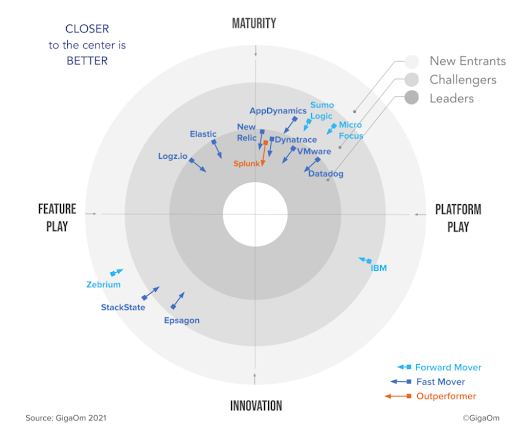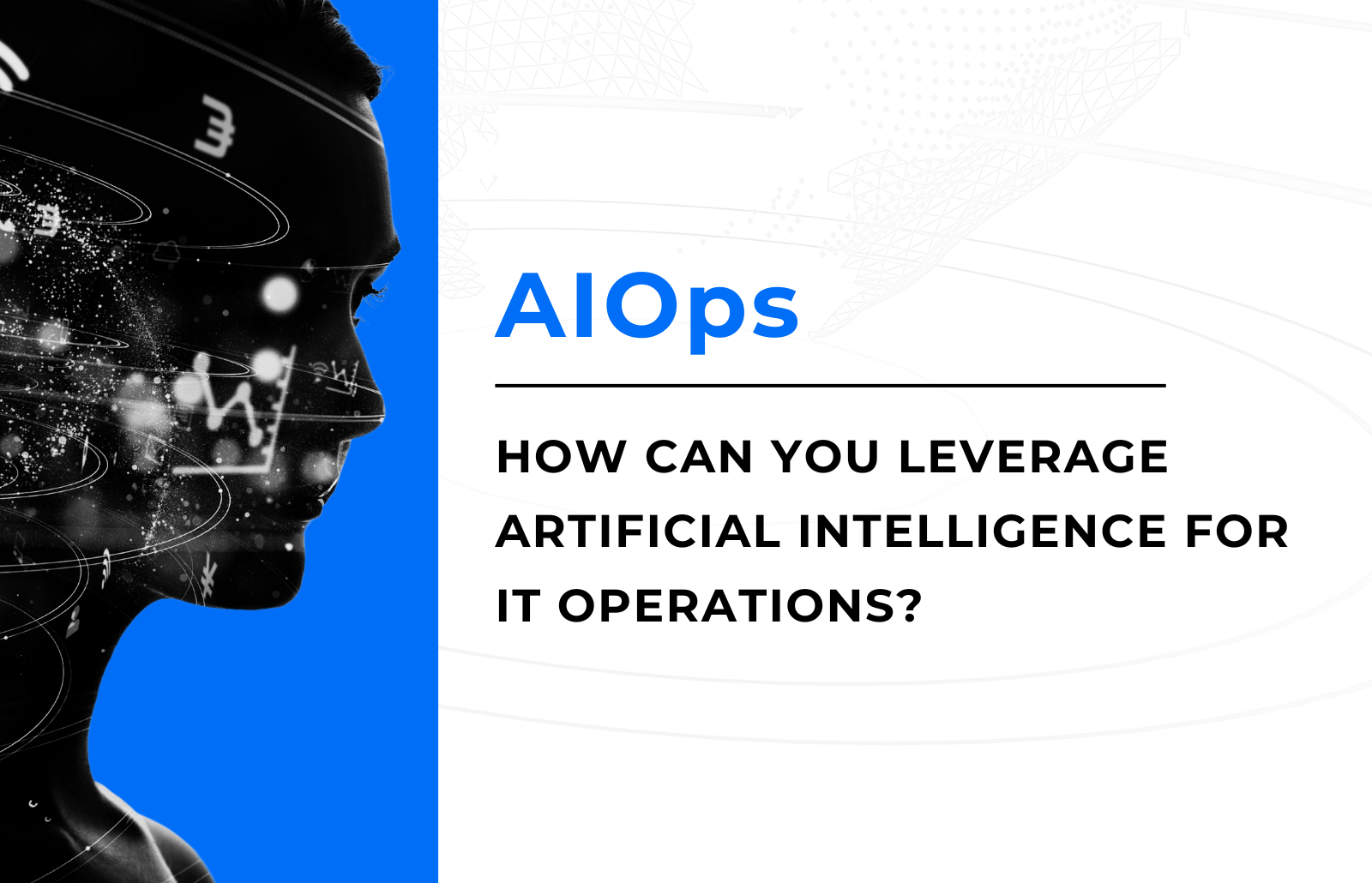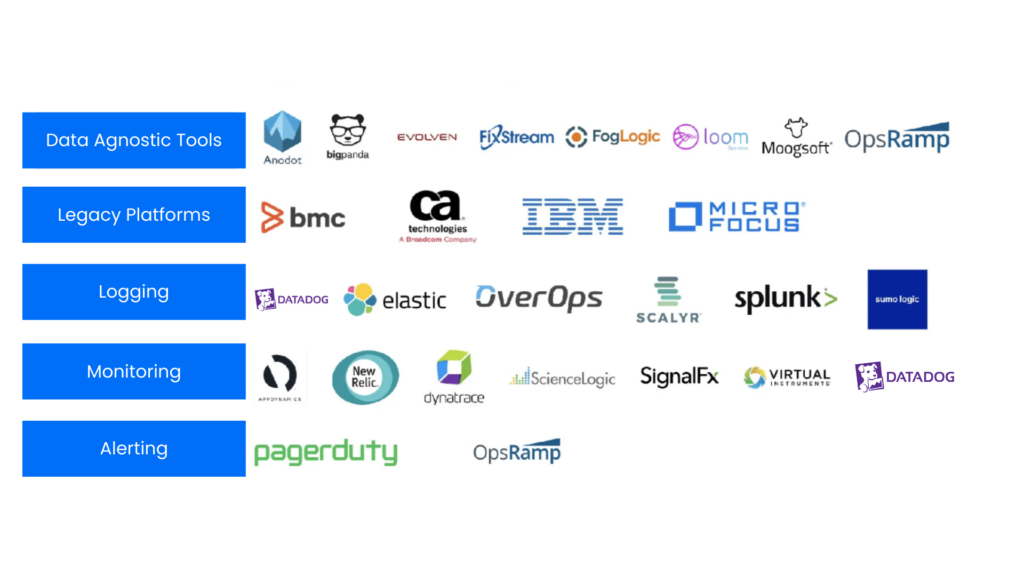In today’s rapidly evolving technological landscape, businesses heavily rely on IT systems and operations to stay competitive. However, with the increasing complexity of IT environments, managing and optimizing IT operations can take lots of time and effort. Artificial Intelligence services for IT Operations (AIOps) enters into action at this point.
AIOps combines the power of artificial intelligence and machine learning algorithms, including techniques such as natural language processing, to revolutionize IT operations, enabling organizations to enhance efficiency, reduce downtime, and deliver seamless experiences to their customers. In this article, we will explore the concept of AIOps and how you can leverage it to propel your IT operations to new heights.
What is AIOps?
AIOps refers to applying artificial intelligence and machine learning techniques in IT operations to automate and enhance various processes. It involves analyzing vast amounts of data generated by IT systems, such as logs, metrics, events, and user feedback, to gain actionable insights and make informed decisions.
By leveraging advanced analytics and pattern recognition, AIOps enables organizations to proactively identify and resolve issues, predict potential problems, and optimize IT infrastructure. Furthermore, it automates IT operations processes, including event correlation, anomaly detection, and causality determination. As a result, AIOps helps enterprises eliminate errors, streamline workflow processes, improve collaboration, and enhance transparency.
The Benefits of AIOps
By adopting AIOps, organizations can unlock numerous benefits that can transform their IT operations. Some of the key advantages include:
1) Predictive Analysis for Proactive Problem Solving
One of the most significant advantages of AIOps is its ability to analyse a vast volume of data to identify patterns and potential issues. By predicting issues before they occur, AIOps allow IT teams to become proactive in their approach, thereby reducing downtime and enhancing service quality.
2) Anomaly Detection
AIOps platforms continuously monitor operational data and use machine learning algorithms to identify anomalies. These anomalies could range from a sudden server performance drop to an unusual network traffic spike. By detecting these anomalies early on, IT teams can mitigate potential problems before they escalate.
3) Streamlined Incident Management and Response
Automatically categorising and prioritising incidents based on their impact and urgency, AIOps simplifies the incident management process. It even suggests possible solutions based on similar past incidents, thereby expediting resolution.
With AIOps, incidents can also be automatically classified, and assigned to the right teams, streamlining the resolution process and reducing the mean time to repair (MTTR).
- Enhanced Root Cause Analysis: AIOps leverages data correlation and analysis to identify the root causes of incidents, facilitating faster problem resolution and minimizing the impact on end-users.
- Optimized Capacity Planning: AIOps helps organizations optimize their IT infrastructure and resource allocation by analysing historical data and usage patterns, ensuring efficient capacity planning and cost savings.
- Intelligent Automation: AIOps enables the automation of repetitive tasks, freeing up IT teams to focus on strategic initiatives and driving innovation within the organization.
Harnessing AIOps for Optimisation and Collaboration
Optimising Capacity with AIOps
By analysing usage patterns and predicting future demand, AIOps aid in resource optimisation. This predictive capability informs decisions about scaling IT infrastructure up or down, ensuring optimal utilisation of resources.
Enhanced Integration and Collaboration
AIOps can be integrated with various ITSM and DevOps tools, offering a unified view of the IT landscape. It can play the role of organizing and integrating the functionalities of an organization’s domain-specific IT monitoring and management tools, acting as a coordinating layer that fosters collaboration between different teams, improving operational efficiency.
Managing Data with AIOps
In today’s hyperconnected digital landscape, organisations generate vast amounts of data from various sources, including IT operations, business applications, and IoT devices. This wealth of data can provide invaluable insights into the performance of IT infrastructure and the business as a whole. However, harnessing this data can pose a significant challenge due to its volume, velocity, and variety. This is where AIOps can make a crucial difference, acting as a significant data management component in modern organizations.
Root Cause Analysis
When an issue arises in IT operations, it’s crucial to quickly determine the root cause to minimise the impact on service levels. Traditional root cause analysis methods can be time-consuming and inefficient, especially when dealing with complex IT systems. This is where AIOps shines.
1) Pinpointing the Problem
AIOps platforms utilise machine learning and sophisticated algorithms to trace the origins of a problem. They can sift through layers of interconnected data to pinpoint the exact factor causing an issue. For instance, if a server goes down, AIOps could identify whether it’s due to a hardware failure, a network issue, or an application error.
2) Accelerating Time to Resolution
By identifying the root cause quickly, AIOps can significantly reduce the time it takes to resolve an issue. This leads to less downtime, minimal disruption to business operations, and improved user satisfaction.
3) Preventing Future Issues
Beyond immediate problem-solving, root cause analysis also helps prevent future issues. By understanding what caused a problem, measures can be put in place to prevent similar issues from reoccurring. This contributes to a more robust, resilient IT infrastructure.
By managing data effectively and conducting in-depth root cause analysis, AIOps addresses current IT issues and not only addresses current IT issues but also empowers organisations to build proactive, future-ready IT operations.
Chatbots and Virtual Assistants
AI-powered chatbots and virtual assistants can provide instant support and information to IT teams and end-users. They can handle routine queries, perform basic troubleshooting, and provide self-service options, freeing up IT staff to focus on more complex tasks. Chatbots can also learn from user interactions and continuously improve their responses over time.
Overcoming Data Challenges with AIOps
Traditional data processing methods often struggle with handling the ‘3 Vs’ of Big Data: Volume, Velocity, and Variety.
Volume: The sheer amount of data generated can be overwhelming for conventional data management tools. AIOps platforms, on the other hand, are designed to handle big data and can efficiently process large amounts of data.
Velocity: In the current digital age, data is generated at an extraordinary speed. AIOps can process this data in real-time or near-real-time, allowing for instant insights and faster decision-making.
Variety: Data comes in various formats, including structured, semi-structured, and unstructured data. AIOps platforms can handle all these types of data, ensuring no valuable insights are missed due to the data format.
-
Data Aggregation, Correlation, and Analysis
AIOps platforms can aggregate data from various sources, offering a unified view of the IT environment. They can correlate this data to identify patterns and connections that might not be apparent with manual analysis. The insights generated from this process can be used to optimise IT operations, predict potential issues, and support strategic decision-making.
-
Improving Data Quality
By cleaning and normalising data, AIOps platforms improve data quality. This reduces the risk of making decisions based on inaccurate data and makes it easier for machine learning algorithms to detect patterns and anomalies. High-quality data can enhance the precision of predictive models, leading to more accurate forecasts and better decision-making.
AIOps Tools: Empowering IT Operations
AIOps tools have emerged as powerful solutions for IT operations, combining the strengths of AI and monitoring systems. While some platforms have evolved from established monitoring systems, others have grown from AI labs. These tools excel in predicting machine load and monitoring deviations from expected patterns.
Generating alerts and employing root cause analysis enable efficient troubleshooting and a comprehensive understanding of enterprise application dynamics.
Key Features of AIOps Tools
- Forward-Looking Predictions: Effective AIOps tools generate proactive estimates of machine load and continuously monitor for deviations. Any anomalies can be transformed into alerts, triggering notifications via emails, Slack, or pager messages in case of significant deviations.
- Root Cause Analysis: Advanced AIOps tools provide insightful flowcharts that trace the cascading impact of issues throughout complex enterprise applications. This root cause analysis facilitates efficient problem resolution by understanding the interconnected nature of various machines.
- Seamless Integration: When considering an AIOps platform, evaluating its compatibility with your specific databases and services is essential. The best AIOps tools seamlessly integrate with existing systems, ensuring smooth data flow and enabling comprehensive monitoring.
Choosing the Right AIOps Tool for Your Needs
Deciding on an AIOps tool hinges on a clear understanding of your IT operations and the level of solution required. Broadly, AIOps tools fall into two categories: domain-centric and domain-agnostic. Your choice should align with the specific requirements of your IT environment.
Domain-Centric AIOps Tools:
These tools are tailored to concentrate on a single domain within the system, such as optimizing network performance or managing application performance. If you are an IT team aiming to enhance a specific section of your organization’s network or system, domain-centric solutions could be an excellent choice. They offer detailed insights and specialized features that cater to a particular domain’s requirements.
Domain-Agnostic AIOps Tools:
Domain-agnostic solutions are engineered to gather and analyze data from any system part, addressing various issues. Serving as an all-inclusive management tool, these solutions are suitable for IT teams seeking an AIOps tool that can be integrated system wide. They offer a more generalized approach, providing a holistic view of your IT operations and the ability to spot and rectify problems across the system.
In conclusion, when choosing between different AIOps tools, it’s crucial to consider your specific needs and circumstances. While domain-centric solutions offer a deep dive into specific areas, domain-agnostic tools provide a bird’s-eye view of your operations. Choose based on which perspective will best serve your company’s IT operations needs.
Prominent AIOps Tools
Several notable AIOps tools have proven effective in today’s landscape. Here are some of those:
- AppDynamics: AppDynamics offers a comprehensive AIOps platform with robust monitoring, analytics, and automation capabilities. It provides real-time visibility into application performance and enables proactive incident management.
- BigPanda: BigPanda simplifies IT operations by consolidating alerts and correlating events from various monitoring tools. Its AI-driven platform helps identify critical incidents and reduces alert fatigue.
- Moogsoft: Moogsoft offers an AI-powered AIOps platform that consolidates and correlates alerts from various monitoring tools. It employs machine learning algorithms to detect anomalies and streamline incident management.
- Datadog: Datadog combines infrastructure monitoring, application performance monitoring, and log management in a unified platform. Its AIOps features enable intelligent alerting and fast troubleshooting.
- LogicMonitor: LogicMonitor is a comprehensive monitoring and observability platform that enables IT teams to gain real-time insights into their infrastructure and applications. Its AIOps features help optimize performance and minimize downtime.
- IBM Watson Cloud Pak: IBM Watson Cloud Pak for AIOps offers advanced AI capabilities to detect, diagnose, and resolve IT issues. It employs machine learning algorithms for anomaly detection and root cause analysis.
- Dynatrace: Dynatrace leverages AI-powered automation and observability to deliver precise insights into application performance. Its AIOps capabilities facilitate proactive problem identification and resolution.
- Splunk: Offers a powerful AIOps solution combining data analysis, machine learning, and automation. Its platform enables proactive monitoring, intelligent alerting, and rapid incident response.
- New Relic One: New Relic One provides full-stack observability and AIOps capabilities for modern, complex environments. It helps organizations optimize their software performance, troubleshoot issues, and deliver exceptional user experiences.
- FortiAIOps: FortiAIOps by Fortinet offers an AI and machine learning-powered platform that streamlines IT operations. It provides proactive visibility into your network by swiftly collecting data and identifying network anomalies. This approach aids in enhancing operational efficiency and conserving IT resources.

Implementing AIOps in Your Organization
Step 1: Define Your Objectives
Before embarking on an AIOps journey, it is crucial to clearly define your objectives and identify the specific areas where you want to leverage AI capabilities. Whether it’s improving incident management, enhancing performance monitoring, or streamlining change management, having a clear vision will guide your implementation strategy.
Step 2: Assess Your Current Infrastructure and Skills
Evaluate your current IT infrastructure and identify areas of improvement. Determine if you have the necessary skills within your team to implement AIOps. If not, consider training, hiring new team members or partnering with an external partner to provide you with the dedicated engineers you need.
Step 3: Collect and Consolidate Data
To unleash the power of AIOps, you need a comprehensive and unified data collection strategy. This involves gathering data from various sources, such as monitoring tools, event logs, ticketing systems, and performance metrics. By consolidating this data into a centralized repository, you create a rich dataset that AI algorithms can leverage for analysis and insights.
Step 4: Choose the Right AIOps Tool
Depending on your needs, select an AIOps tool that fits your objectives. Remember, different tools have different strengths. Some are domain-centric, focusing on a specific area like network or application performance, while others are domain-agnostic, offering a broad range of capabilities across your IT operations.
Step 5: Implement in Phases
Start small with a pilot project to test the effectiveness of AIOps in your organization. Gradually expand its use as you gain confidence and understanding.
Step 6: Apply Advanced Analytics
With your data in place, it’s time to apply advanced analytics techniques to gain valuable insights. Machine learning algorithms can be trained on historical data to identify patterns, anomalies, and correlations. This enables predictive analytics, allowing you to forecast potential issues and take proactive measures to mitigate them.
Step 7: Implement Intelligent Automation
One of the significant advantages of AIOps is the ability to automate routine and repetitive tasks. By deploying intelligent automation, you can streamline incident management, automate repetitive workflows, and enable self-healing capabilities. This frees up your IT teams to focus on high-value activities and innovation.
Step 8: Train Your Teams
Ensure your IT teams understand how to use the AIOps tools effectively. Provide training and resources to help them make the most of the technology.
Step 9: Continuously Monitor and Improve
AIOps is not a one-time implementation; it requires continuous monitoring and improvement. Regularly assess the performance of your AI models, validate their accuracy, and refine them based on evolving business needs. Additionally, stay updated with the latest advancements in AI and incorporate new techniques to enhance your AIOps capabilities.
Step 10: Stay Updated
AI and machine learning are rapidly evolving fields. Stay updated with the latest advancements and incorporate new techniques to enhance your AIOps capabilities.
Concluding Thoughts
AIOps presents a transformative approach to IT operations, leveraging the power of artificial intelligence and machine learning to drive efficiency, improve incident management, and optimize IT infrastructure. By embracing AIOps, organizations can proactively address issues, predict potential problems, and deliver exceptional customer experiences. To stay ahead in today’s competitive landscape, consider adopting AIOps and unlock the full potential of your IT operations.
Zartis: Process Improvement Consulting for Harnessing the Power of AIOps
Are you ready to unlock the transformative power of Artificial Intelligence for your IT Operations? Zartis provides top-notch consulting services, including process improvement consulting, to help businesses harness the power of Artificial Intelligence for IT Operations (AIOps). With our expertise and knowledge, Zartis enables organizations to leverage AI-driven tools and techniques for enhanced monitoring, predictive analysis, and proactive incident management.
Through our process improvement consulting, Zartis assists businesses in optimising their IT operations, improving efficiency, and ensuring seamless system performance. Visit Zartis’ website to learn more about our process improvement consulting services and how we can assist your organization in harnessing the benefits of AIOps.
Don’t miss out on this opportunity to revolutionise your IT operations! Contact us now and discover how we can empower your organisation with the cutting-edge capabilities of Artificial Intelligence in IT Operations.



